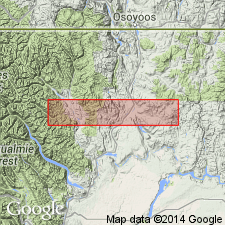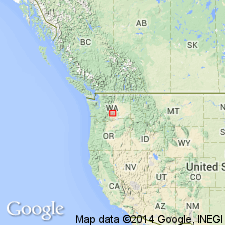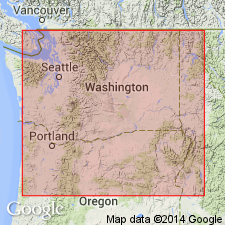
- Usage in publication:
-
- Squaw Creek diatomite member
- Modifications:
-
- Named
- Dominant lithology:
-
- Diatomite
- AAPG geologic province:
-
- Columbia basin
Summary:
Name proposed for member of Yakima basalt. Defined as occurring one flow below top of Yakima basalt in Yakima-Ellensburg area, south-central WA. In Squaw Creek syncline, member consists of bed of essentially pure diatomite 7 to 17 feet thick. Conformably underlies lacustrine siltstone (0 to 10 feet thick) which in turn underlies, with slight erosional unconformity, a quartz-rich sandstone and pea conglomerate (0 to 20 feet thick). Diatomite formed in one or more fresh-water lakes of great areal extent. Rests everywhere on basalt, and was overspread by uppermost one or two Yakima flows.
Type locality not stated. Occurs in Yakima-Ellensburg area, south-central WA.
[NOTE: The Department of the Interior's Secretarial Order 3404, issued on November 19, 2021, formally identifies the term “squaw” as derogatory. That Order will create a federal Derogatory Geographic Names Task Force, to find replacement names for geographic features in use by federal agencies. We’re awaiting guidance from the Task Force, and will then take the appropriate actions.]
Source: GNU records (USGS DDS-6; Menlo GNULEX); US geologic names lexicon (USGS Bull. 1200, p. 3700-3701).

- Usage in publication:
-
- Squaw Creek Diatomite Bed*
- Modifications:
-
- Principal reference
- Revised
- Adopted
- AAPG geologic province:
-
- Eastern Columbia basin
Summary:
Pg. G8. Squaw Creek Diatomite Bed of Frenchman Springs Member of Yakima Basalt of Columbia River Group. Diatomite, 5 to 17 feet thick; grades westward into sandstone and pebble conglomerate composed of partly tuffaceous and partly of granitic detritus. Underlies Roza Member of Yakima Basalt. Where Squaw Creek is not present, silicified wood or odd-shaped siliceous concretions mark contact between Frenchman Springs Member and overlying Roza Member. Age is late Miocene.
Type section: on Squaw Creek, in T. 15 N., R. 20 E., Kittitas Co., WA.
[NOTE: The Department of the Interior's Secretarial Order 3404, issued on November 19, 2021, formally identifies the term “squaw” as derogatory. That Order will create a federal Derogatory Geographic Names Task Force, to find replacement names for geographic features in use by federal agencies. We’re awaiting guidance from the Task Force, and will then take the appropriate actions.]
Source: Publication; Changes in stratigraphic nomenclature, 1966 (USGS Bull. 1254-A, p. A7); GNU records (USGS DDS-6; Menlo GNULEX).

- Usage in publication:
-
- Squaw Creek Member*
- Modifications:
-
- Revised
- Age modified
- AAPG geologic province:
-
- Columbia basin
Summary:
Squaw Creek Diatomite Bed (Frenchman Springs Member of Yakima Basalt) (Bingham and Grolier, 1966) and Quincy Diatomite Bed (Priest Rapids Member of Yakima Basalt) are renamed Squaw Creek Member because it is chiefly sandstone and siltstone toward west and is reassigned as middle member of 3 to Ellensburg Formation. Squaw Creek Member merges with Ellensburg Formation to the west. Name Quincy Diatomite Bed is here abandoned because it is apparently equivalent to Squaw Creek Diatomite Bed. Age is middle Miocene [based on stratigraphic relations].
[NOTE: The Department of the Interior's Secretarial Order 3404, issued on November 19, 2021, formally identifies the term “squaw” as derogatory. That Order will create a federal Derogatory Geographic Names Task Force, to find replacement names for geographic features in use by federal agencies. We’re awaiting guidance from the Task Force, and will then take the appropriate actions.]
Source: GNU records (USGS DDS-6; Menlo GNULEX).
For more information, please contact Nancy Stamm, Geologic Names Committee Secretary.
Asterisk (*) indicates published by U.S. Geological Survey authors.
"No current usage" (†) implies that a name has been abandoned or has fallen into disuse. Former usage and, if known, replacement name given in parentheses ( ).
Slash (/) indicates name conflicts with nomenclatural guidelines (CSN, 1933; ACSN, 1961, 1970; NACSN, 1983, 2005, 2021). May be explained within brackets ([ ]).

